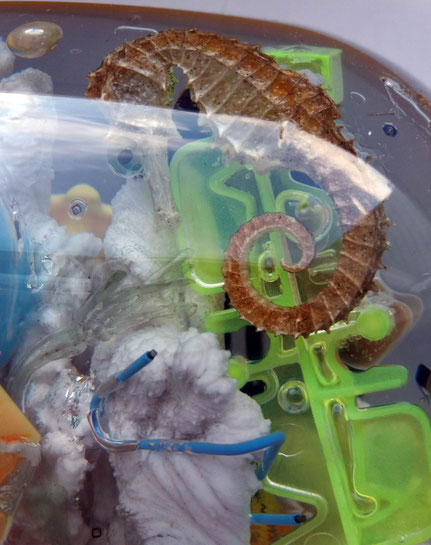Plastganic
Az átváltozás sikeres: a műanyag alkatrészek túl jól is kommunikálnak az élő korál képében, a rezonancia köztök feltűnően működik, nem okoznak meglepetést behelyettesítsük. Az előre nem pontosan látható lencsehatásból adódó buborék effekt egy új elemmel bővíti ugyan az összhatást, mégpedig a kínai piacon kapható tengeri témájú kulcstartók hangulata. Akár jó is lehetne a plusz tartalom1, csakhogy éppen ellene dolgozik a montázs mechanizmusából származó feszültségnek, mivel túlságosan hasonlóak.
Hommage à Gábor Kerekes
Géza Szöllősi’s experimenting character and sensitivity to Kerekes’s pictures further enhances the specific atmosphere of the exhibition that resembles to an alchemist’s workshop. Szöllősi represents young artists’ generation and makes contact with the photographs in a fresh and provocative tone, using his synthetic resin sculptures and his own creative language. Each vintage-like object, casted in mystic and shiny plastic cubes, is connected to the photographs of Kerekes, converting the gloomy, archaic images into 3D reality. Differently shaped glass dildos, feathers, aircraft cemeteries, frog skeletons, octopuses, and transparent globes sparkle in the synthetic resin cubes, and represent the paradox of preservation and passing away.
Photos by György Darabos
Video
Art+Text Budapest
Body, Fetish, Death
Gábor Kerekes - Géza Szöllősi
Máthé Tekla Noémi:
"Szöllősi egy különleges karaktere a magyar képzőművészeti világnak. Vizuális művészként aposztrofálja magát, a Moholy-Nagy Művészeti Egyetemen végzett, és olyan filmekben működött közre, mint például a Taxidermia Pálfi György, vagy az Ópium Szász János rendezésében.
A kiállításon szereplő fotókat tulajdonképpen újrakreálja a térben, vagy azokat a motívumokat hozza létre valódi tárgyakból. Művészetének jellegzetessége a kollázs technika. Végeredményben ő is szimulál, létrehoz tárgyakból, anyagokból egy arcot, vagy egy testet. Hússzobrairól híresült el több mint tíz éve, melyek különböző állati húsokból összevarrt portrékat ábrázoló szobrok, női szeméremtestek. A hús romlandó anyag, ahogy maga a test is, tehát tulajdonképpen újraalkotja az emberi testet a maga valójában. Művei feszültséget keltenek, illetve problémákat vetnek fel, mivel átlépnek egy bizonyos határt, felborítják a szimbolikus rendet, melyet civilizációnk jelent. A határok az élő és az élettelen, az ember és az állat, a mesterséges és a természetes, szép és rút között húzódnak, áthágásuk felkavarja a szemlélőt.
Szöllősi szimulációja akkor a legérdekesebb, mikor egy absztraktabb képre reflektál. Például egy közelről lefotózott szemet újraalkot egy gombából. Ez egy új eljárás, aminél ismét arról van szó, hogyan lehet az élő anyagokat kollázs-szerűen összerakni és tartósítani. Víztiszta, áttetsző műgyantából önti ki ezeket a kis szobrokat, melyekből a legújabbak megtekinthetők voltak a kiállításon."
ART+TEXT BUDAPEST’s new exhibition, focusing on the conceptual threefold of body-fetish-death, displays a unique section of the rich and wide-ranging oeuvre of the photographer Gábor Kerekes, who passed away two years ago, aged 69. Bizarre accessories, scientific evidences, eerie focuses and strange toys evoke the ephemeral nature of human existence and bodily desires, and the experience of the closeness of death – both in the archaizing photographs of Kerekes and in the synthetic resin hommages of Géza Szöllősi inspired by Kerekes’s works.
The chosen motifs and the historical techniques (gelatine silver print, albumin paper, anthracotic, etc.) form a dramatic unit in Kerekes’s works. The exhibition presents pieces from the photographer’s different periods – but most importantly from his last one – that are dominated by a “historical bizarre” atmosphere. This further gets strengthened in the pictures where he creates “death-portraits” using his own body, in the alchemist-like scientific macro-photos, in the vintage beauty of sex toys, and in the frivol accessories of the fetishes of madness. The detailed examination, technical experimenting, and the sometimes obscure choice of themes unite Kerekes’s oeuvre. The difficult procedures of the 19th century anarcotics raise the artistic actions to a higher level; Kerekes carried out all working processes himself, with the accuracy of a surgeon.
Géza Szöllősi’s experimenting character and sensitivity to Kerekes’s pictures further enhances the specific atmosphere of the exhibition that resembles to an alchemist’s workshop. Szöllősi represents young artists’ generation and makes contact with the photographs in a fresh and provocative tone, using his synthetic resin sculptures and his own creative language. Each vintage-like object, casted in mystic and shiny plastic cubes, is connected to the photographs of Kerekes, converting the gloomy, archaic images into 3D reality. Differently shaped glass dildos, feathers, aircraft cemeteries, frog skeletons, octopuses, and transparent globes sparkle in the synthetic resin cubes, and represent the paradox of preservation and passing away.
The simple, clear settings of the photographs have transcendental power. Szöllősi uses these still lives with great respect, converts them and extends them in space. One of the main objects of his work – using his own words – is to reach a certain “turning point” from the everydays into an ethereal, esoteric dimension. Gábor Kerekes is the perfect partner for this, since both artists search for the invisible exit from the ephemeral and pulverizing vale of tears using the threefold of body-fetish-death.
The exhibition was realized with the collaboration of the Gábor Kerekes Archive and Zsolt Péter Barta, estate administrator.
A test-fétis-halál fogalmi hármas köré szervezett kiállítás különleges keresztmetszetét mutatja be a két évvel ezelőtt, 69. életévében elhunyt Kerekes Gábor fotográfus gazdag és sokrétű életművének. Az archaikus technikákat tudományos fényképekkel vegyítő Kerekes egy alkimista fotós lencséjén keresztül vizsgálta a tapintható külvilágot és az emberi psziché titkos mozgatórugóit. Az Einspach Gábor által válogatott anyagban a kitömött állatszobrok és a bizarr okkultizmus fiatal mestere, Szöllősi Géza reflektál Kerekes műveire a test-fétis-halál témaköréhez nagyon is illő saját hangján. A kiállítás a Kerekes Gábor Archívum-KGA és Barta Zsolt Péter hagyatéki kezelő közreműködésével jött létre. A kiállítás megtekinthető: Március 24-től Április 24.-ig
Géza Szöllősi is a skilled multi-disciplinary artist working in a wide variety of mediums including taxidermy, animal flesh, photography and graphics. He worked as designer in several award-winning Hungarian films like Opium and The Notebook and Taxidermia.
Géza's artworks has been exhibited alongside artists such as Jake and Dinos Chapman, Jeff Koons, Cindy Sherman in the 'Decadence Now! Visions of Excess' organised by Galerie Rudolfinum, Prague. His work is held in collections in Miami, New York, Seoul, London, Prague and Budapest.





















